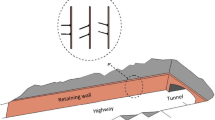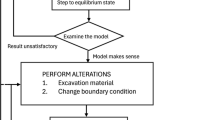Abstract
The seepage reduction in embankment dams is essential to their stability and safety. This research aims to evaluate the effects of penetration depth (16, 18, 20, 22, 24 m), distance from the beginning of the crest width (0, 2, 4, 6, 8 m), and inclination angle (45°, 90°, 135°) of the internal cutoff wall on some of the design parameters in an embankment dam using the Finite Element Method. It was found that the existence of an internal cutoff wall leads to a significant decline in the phreatic line level. Increasing the internal cutoff wall penetration depth decreases seepage flow so that the maximum decline in seepage flow rate is 39.7% for a penetration depth of 24 m. In contrast, by increasing the internal cutoff wall penetration depth, hydraulic gradient and relative drop in total head increases. In addition, as the distance of the internal cutoff wall from the upstream end of the crest width increases, the seepage discharge and hydraulic gradient increase. For a penetration depth of 22 m, the maximum decrease in seepage discharge was about 31.23% for x = 0 m. It was seen that by increasing the inclination angle of the internal cutoff wall, the maximum hydraulic gradient occurred in more downstream locations. An internal cutoff wall with inclination angle of 45° and penetration depth of 24 m was found to have the best performance at reducing seepage by 49.7%. The relative drop in the total head reaches the maximum value with a cutoff inclination angle of 135°.
















Similar content being viewed by others
Data availability
The datasets generated during and/or analysed during the current study are available from the corresponding author on reasonable request.
References
Abdel-Kawy AO, AboulAtta NM, El-Molla DA (2021) Effects of core characteristics on seepage through earth dams. Water Pract Technol 16(4):1248–1264. https://doi.org/10.2166/wpt.2021.053
Abokwiek R, Al Sharabati M, Hawileh R, Abdalla JA, Sabouni R, Husseini GA (2022) A finite element model for the analysis of seepage flow of water under concrete dams. Geotech Geol Eng 40:2823–2841. https://doi.org/10.1007/s10706-022-02065-1
Al-Janabi AMS, Ghazali AH, Ghazaw YM, Afan HA, Al-Ansari N, Yaseen ZM (2020) Experimental and numerical analysis for earth-fill dam seepage. Sustainability 12(6):2490. https://doi.org/10.3390/su12062490
Arifin MZ, Purwana YM, Dananjaya RH (2023) Seepage and piping control of earth fill dam. In: Proceedings of the 5th international conference on rehabilitation and maintenance in civil engineering, lecture notes in civil engineering. https://doi.org/10.1007/978-981-16-9348-9_28
Armanuos AM, Negm AM, Javadi AA, Abraham J, Gado TA (2022) Impact of inclined double-cutoff walls under hydraulic structures on uplift forces, seepage discharge and exit hydraulic gradient. Ain Shams Eng J 13(1):101531. https://doi.org/10.1016/j.asej.2021.06.017
Attia M, Abdel Razek M, Salam AA (2021) Seepage through earth dams with internal cut off. Geotech Geol Eng 39(8):5767–5774. https://doi.org/10.1007/s10706-021-01865-1
Beiranvand B, Komasi M (2021) An Investigation on performance of the cut off wall and numerical analysis of seepage and pore water pressure of Eyvashan earth dam. Iran J Sci Technol Trans Civ Eng 45(3):1723–1736. https://doi.org/10.1007/s40996-021-00613-y
Belew AZ, Tenagashaw DY, Ayele WT, Andualem TG (2022) Coupled analysis of seepage and slope stability: a case study of Ribb Embankment Dam, Ethiopia. Water Conserv Sci Eng 7:293–314. https://doi.org/10.1007/s41101-022-00143-2
Cavus US, Kilit M (2022) Safety assessment and treatment techniques of an operated dam with a leakage problem: case study of Hisarardi embankment dam. Environ Earth Sci 81:546. https://doi.org/10.1007/s12665-022-10668-3
Charrak H, Smail N, Rouissat B (2022) Parameterized analysis relating to the influence parameters of injections and drainages in dams foundations. Case of El izdihar dam, Sidi Abdelli, Algeria. Model Earth Syst Environ 8(3):2991–3004. https://doi.org/10.1007/s40808-021-01277-3
Chen Y, Xue B, Zhang S, Du X, Shi M (2022) Seepage characteristics analysis on earth dams considering polymer cutoff wall with construction defects. Case of El izdihar dam, Sidi Abdelli, Algeria. Sustainability 14(19):11879. https://doi.org/10.3390/su141911879
Chouireb M, Djehiche A (2019) Simulation of seepage flow through an earthen dam with vertical drain and comparison of results with observations data (case study: Harreza dam-Algeria). Arab J Geosci 12(13):406. https://doi.org/10.1007/s12517-019-4542-6
Das BM (2008) Advanced soil mechanics. Taylor & Francis, New York
Dupuit J (1863) Etudes Théoriques et Pratiques sur le Mouvement des Eaux, Dunod, Paris
El Molla DA (2019) Seepage through homogeneous earth dams provided with a vertical sheet pile and formed on impervious foundation. Ain Shams Eng J 10(3):529–539. https://doi.org/10.1016/j.asej.2018.12.008
Garg SK (2020) Irrigation engineering and hydraulic structures. Water resources engineering, vol II. Khanna Publisher, Delhi
Hager WH, Schleiss AJ, Boes RM, Pfister M (2020) Hydraulic engineering of dams. CRC Press, Balkema
Kheiri G, Javdanian H, Shams G (2020) A numerical modeling study on the seepage under embankment dams. Model Earth Syst Environ 6(2):1075–1087. https://doi.org/10.1007/s40808-020-00742-9
Kratochvil S, Hálek V (1961) Efficacité des éléments d’étanchéité des barrages en terre réalisés sur un terrain perméable. Trans. 7th ICOLD, Rome
Kumar S, Sahu A, Kumar M (2022) Modeling the effect of central impervious core and downstream filter geometry on seepage through earth dams. Ain Shams Eng J 13(1):101510. https://doi.org/10.1016/j.asej.2021.05.024
Lane EW (1935) Security from Under-Seepage-Masonry Dams on Earth Foundations. Trans Am Soc of Civ Eng 100(1):1235–1272. https://doi.org/10.1061/TACEAT.0004655
Mansuri B, Salmasi F, Oghati B (2014) Effect of location and angle of cutoff wall on uplift pressure in diversion dam. Geotech Geol Eng 32(5):1165–1173. https://doi.org/10.1007/s10706-014-9774-3
Moharrami A, Moradi G, Bonab MH, Katebi J, Moharrami G (2015) Performance of cutoff walls under hydraulic structures against uplift pressure and piping phenomenon. Geotech Geol Eng 33(1):95–103. https://doi.org/10.1007/s10706-014-9827-7
Norouzi R, Salmasi F, Arvanaghi H (2020) Uplift pressure and hydraulic gradient in Sabalan Dam. Appl Water Sci 10(5):111. https://doi.org/10.1007/s13201-020-01195-2
Novák P, Moffat A, Nalluri C, Narayanan R (2017) Hydraulic structures. CRC Press, London
Pakmanesh M, Jahromi SHM, Khosrojerdi A, Darvishi HH, Babazadeh H (2021) Experimental and numerical study of upstream slope stability in an earth dam reservoir under rapid drawdown conditions. Progress Comput Fluid Dyn 21(4):248–260
Refaiy AR, AboulAtta NM, Saad NY, El-Molla DA (2021) Modeling the effect of downstream drain geometry on seepage through earth dams. Ain Shams Eng J 12(3):2511–2531. https://doi.org/10.1016/j.asej.2021.02.011
Salem MN, Eldeeb H, Nofal S (2019) Analysis of seepage through earth dams with internal core. Int J Eng Res 8:768–777
Salim IH, Othman BS (2021) The effect of inclined intermediate sheet pile on seepage properties under hydraulic structure using SEEP/W program. In: IOP conference series: materials science and engineering. IOP Publishing
Shakouri B, Mohammadi M (2020) Evaluation of penetration depth for cutoff walls in the core of earth dams. Geotech Geol Eng 38(1):151–167. https://doi.org/10.1007/s10706-019-01004-x
Taghvaei P, Mousavi SF, Shahnazari A, Karami H, Shoshpash I (2018) Experimental and numerical modeling of nano-clay effect on seepage rate in earth dams. Int J Geosynth Ground Eng 5(1):1. https://doi.org/10.1007/s40891-018-0152-8
Ullah A, Kassim A, Alam I, Junaid M, Ahmad IS (2019) Efficiency analysis of seepage of Baz Ali small dam, Kurram Agency using clay blanket and cut-off wall with sand filter. Bull Geol Soc Malays 67:113
Acknowledgements
The authors express their gratitude to all the staff of the water and environmental faculty of Shahid Chamran University (SCU, Grant no. SCU.WH1400.343).
Funding
No funding was received to assist with the preparation of this manuscript.
Author information
Authors and Affiliations
Corresponding author
Ethics declarations
Conflict of interest
The authors have no competing interests to declare that are relevant to the content of this article.
Additional information
Publisher's Note
Springer Nature remains neutral with regard to jurisdictional claims in published maps and institutional affiliations.
Rights and permissions
Springer Nature or its licensor (e.g. a society or other partner) holds exclusive rights to this article under a publishing agreement with the author(s) or other rightsholder(s); author self-archiving of the accepted manuscript version of this article is solely governed by the terms of such publishing agreement and applicable law.
About this article
Cite this article
Haghdoost, M., Lakzian, E., Norouzi, R. et al. Numerical simulation using the finite element method to investigate the effect of internal cutoff walls on seepage and hydraulic gradients in homogeneous earth dams. Model. Earth Syst. Environ. 9, 3851–3864 (2023). https://doi.org/10.1007/s40808-023-01755-w
Received:
Accepted:
Published:
Issue Date:
DOI: https://doi.org/10.1007/s40808-023-01755-w




